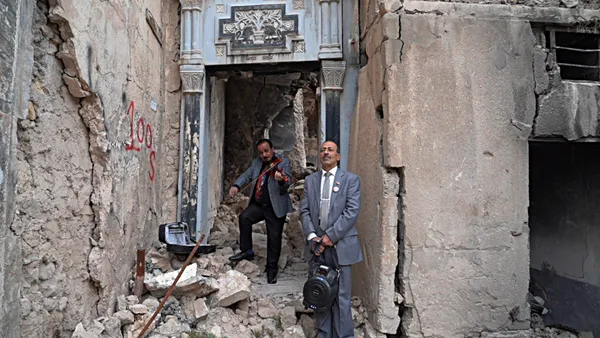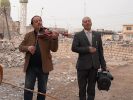Eye For Film >> Movies >> The Lions By The Tigris (2025) Film Review
The Lions By The Tigris
Reviewed by: Amber Wilkinson

War inevitably turns a spotlight onto a country, with news reporters often trailing documentarians in their wake, and for good reason. But it’s frequently the case that once the bullets stop flying, the cameras move on. In The Lions By The River Tigris, Zaradasht Ahmed returns to Mosul to take a look at what has happened next.
Iraq’s second largest city has a rich cultural history stretching back centuries but much of it was left in ruins when, after the withdrawal of US troops in 2011, it fell to Islamic State. Beyond the shelling of the city during its liberation in 2017, IS also had a destructive mindset when it came to cultural antiquities – depressing archive footage included here shows them smashing artefacts in the museum. When the militants were finally ousted much of the city was left a bombed out shell and, despite promises of rebuilding from the government, once glance tells you it’s a Herculean task.

“Where would you start?” asks Bashar Salih. He’s talking as he stands in what was once his family’s beautiful home, seized by IS during the fighting and used as a bomb-making factory before being reduced to rubble. Little remains except for the door frame with its pretty carved lintel depicting the lions of the film’s title. Bashar returns to what remains of the house frequently, dreaming of rebuilding it against the odds. When his wife suggests he is retraumatising himself with repeated visits, he says: “I’m addicted.”
The door lintel has also caught the eye of Fakhri Al Jawal, who wanders the bombed out streets with his musician friend Fadil Al Badri. Fakhri is a military-veteran-turned-collector of cultural artefacts – having created an Aladdin’s cave of sorts, crammed with everything from Seventies alarm clocks to china and brass that he has branded a museum. He wants the lions to stand over the entrance as its crowning glory but as the last vestige of Bashar’s past, he doesn’t want to let them go, the tension between their two perspectives driving the film. Fakhri is also a documentarian’s ‘dream’ character, thanks to his penchant for dapper suits and enormous photos of himself that also adorn his museum.
Ahmed doesn’t need to include war footage for us to feel its weight and understand its shadow. Buildings on the verge of collapse stand testimony to that, although there are also hopeful signs, not just in Fakhri’s collection, but in street markets that are once again bustling and in the museum, where restorers painstakingly try to piece artefacts back together. Fadil also provides a vivid reminder of the IS regime, recalling how he hid his oud and violin during the IS years, now determined to let his music sing out everywhere.
It’s impossible not to feel for Bashar as he digs at the rubble of his home, hoping to find lost photograph albums but discovering only old nets and the bones of IS fighters. Strong first-person testimony drives the film, with Ahmed – who was also its cinematographer – paying attention to both the destruction and the rebuilding that is afoot. It’s clear that IS’s attempts to quash cultural identity and women’s rights have, in fact, had the opposite effect but more female voices in this film would be welcome. There’s a sense that more about how things have changed for women in the city lies tantalisingly just outside the frame.
Those lions are the perfect encapsulation of a city in flux. At once a testimony to the resilience of people like Bashar, Fakhri and Fadil and a reminder of what they have lost as well as a reflection of the precariousness of their uncertain future.
Reviewed on: 04 Apr 2025
















